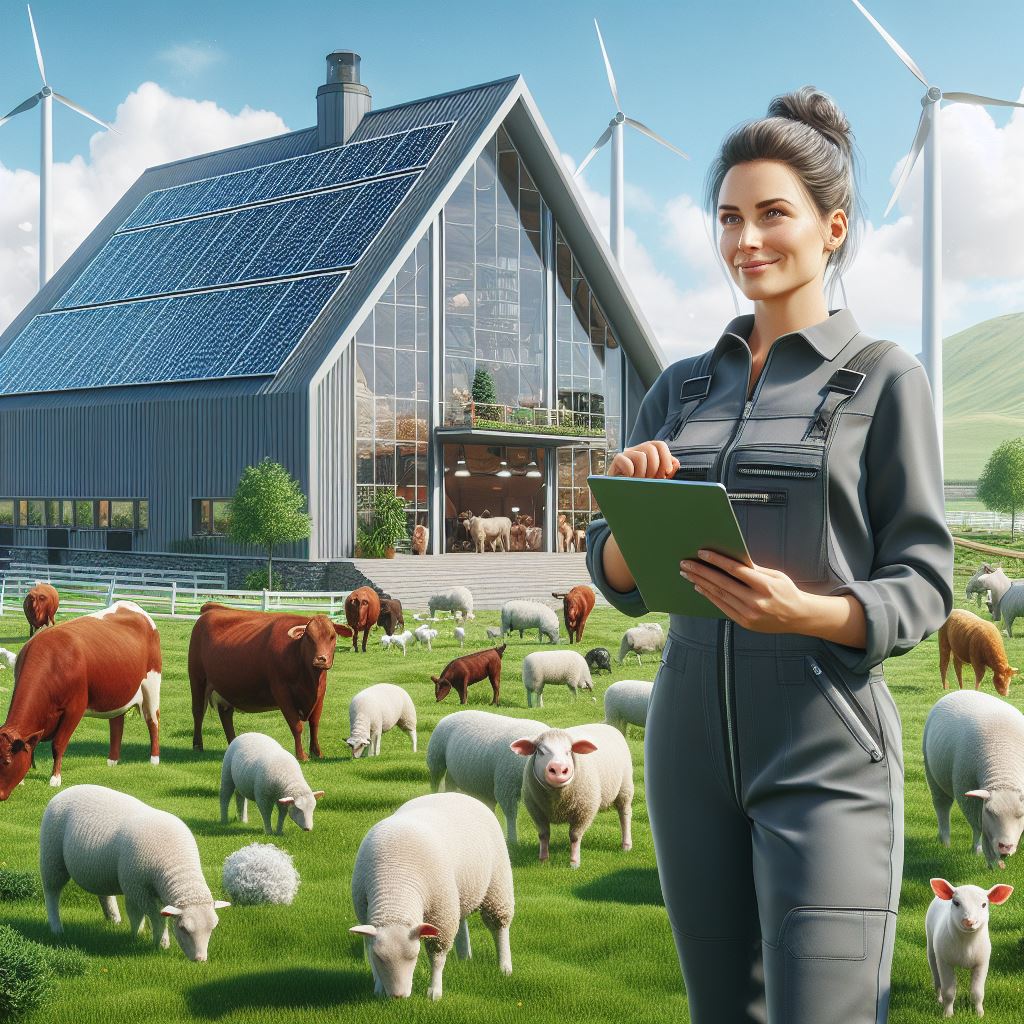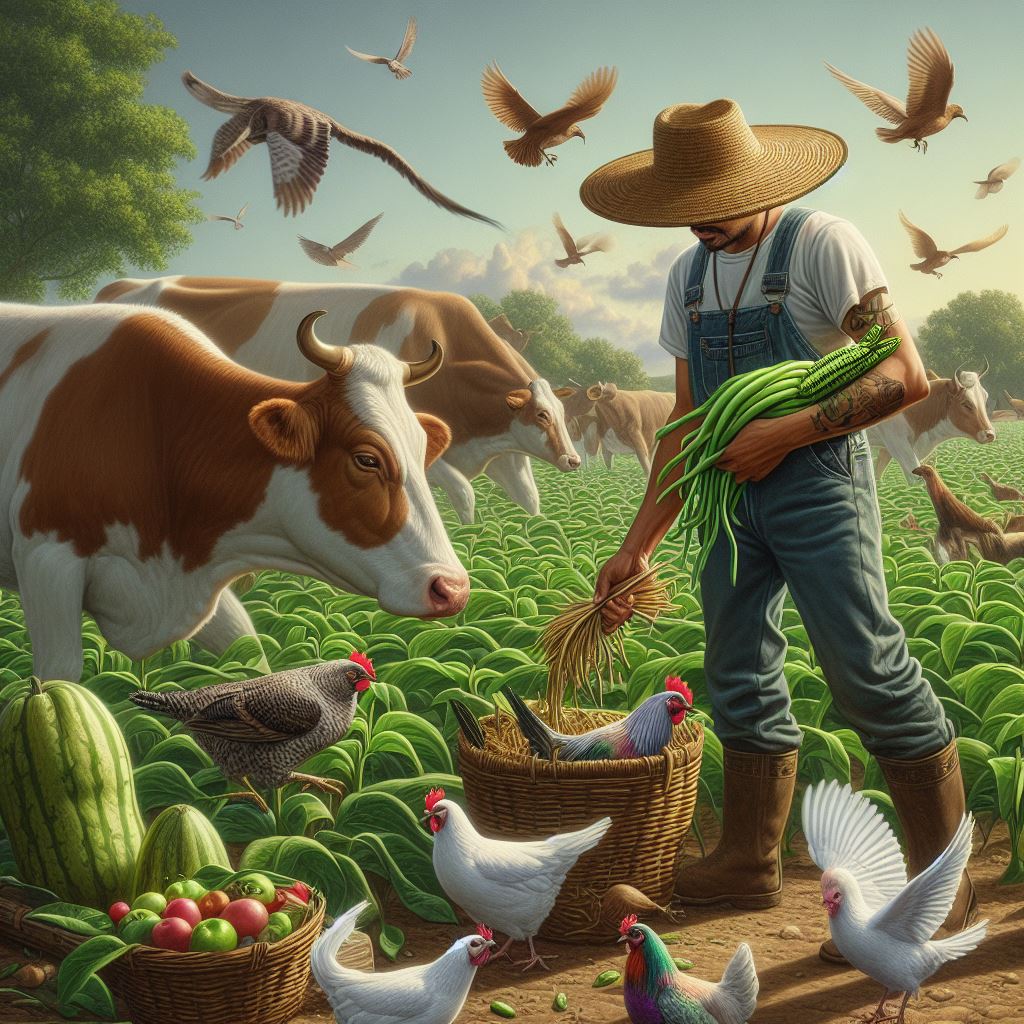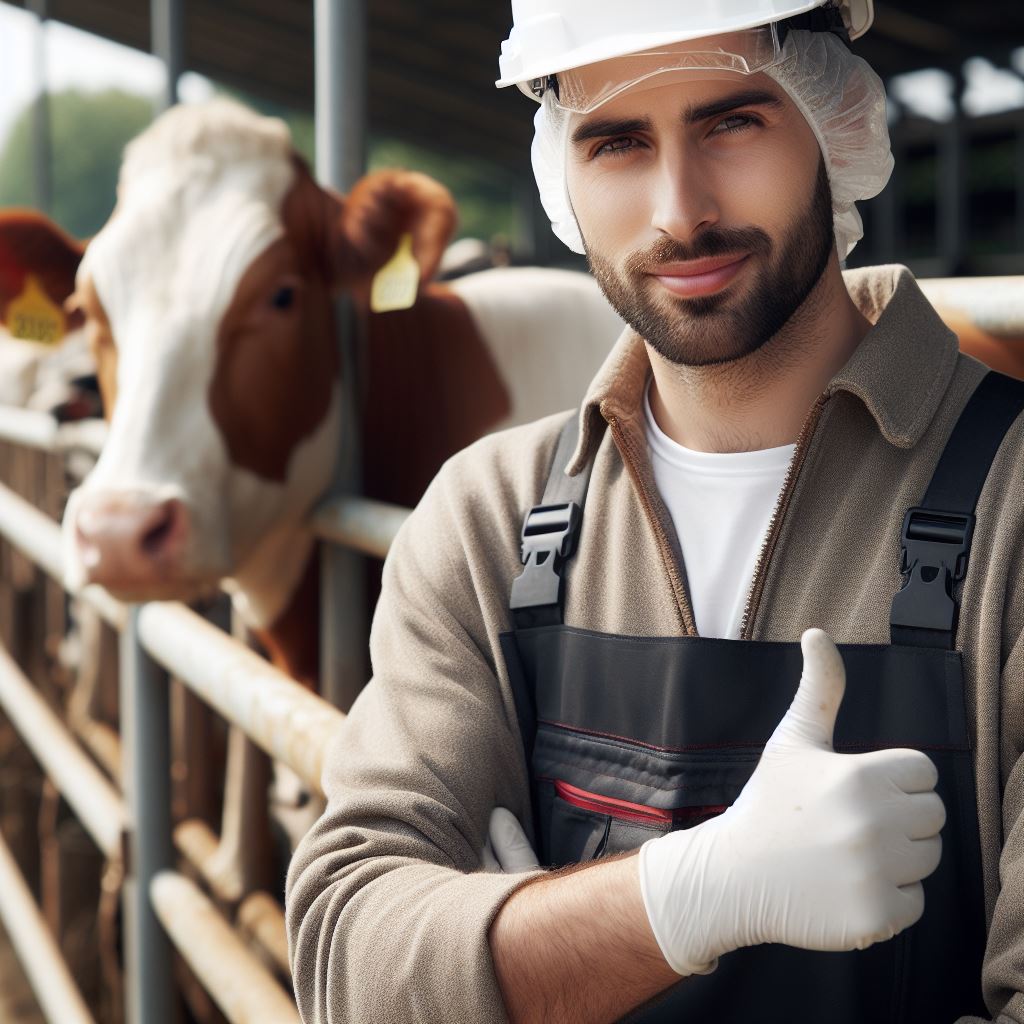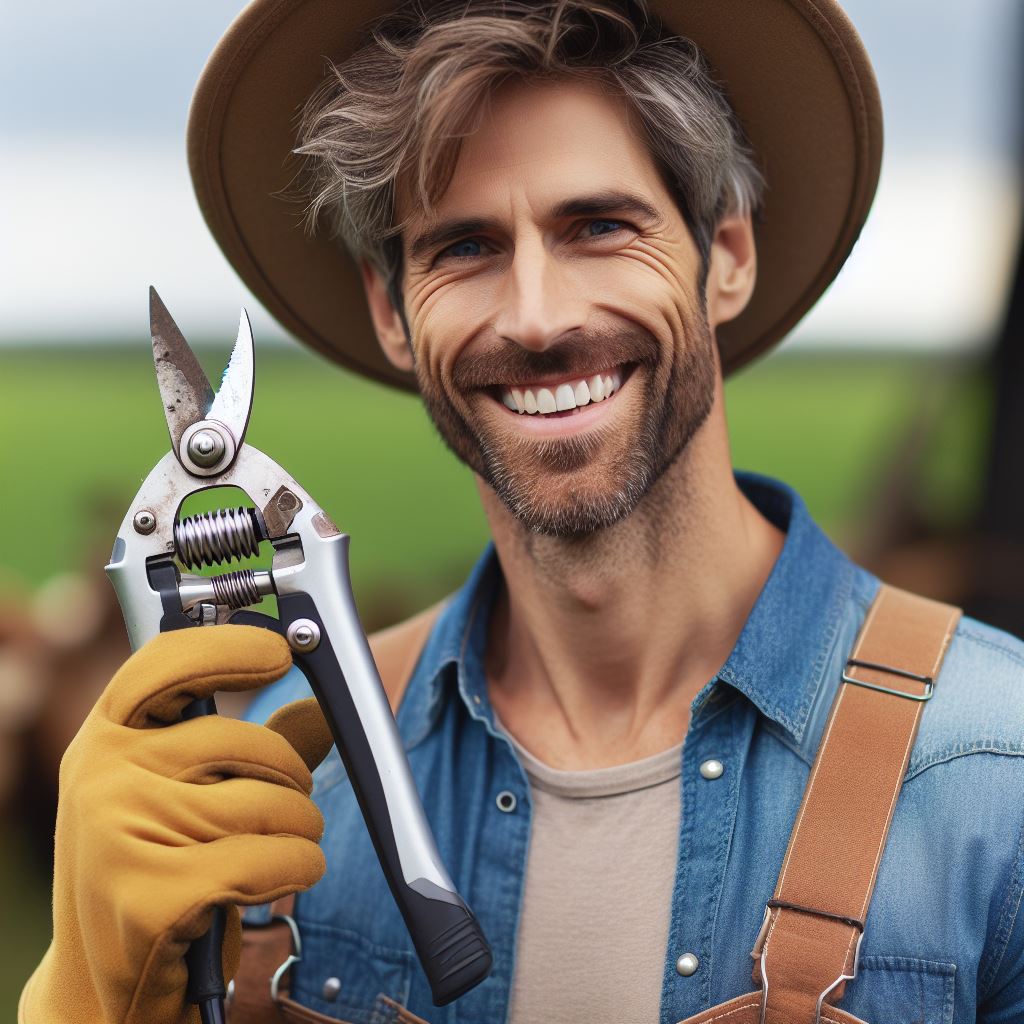Introduction
Livestock safety is paramount in the farming industry. Farmers understand the significance of keeping their animals secure and protected at all times.
Safeguarding livestock not only ensures their welfare but also affects the productivity and profitability of a farm.
To ensure livestock safety, high-tech fencing solutions have become essential.
Traditional fences may not be effective in deterring predators or preventing escapes, thus compromising the well-being and security of animals.
Advanced technologies offer more reliable alternatives to enhance protection and reduce the risk of incidents.
This blog post aims to shed light on the benefits of implementing high-tech fencing solutions.
By exploring various innovative options such as electric fences, GPS tracking systems, and RFID tags, farmers can better understand how to enhance their livestock safety measures.
These high-tech solutions offer improved control, enhanced monitoring capabilities, and timely notifications of potential threats.
Furthermore, this blog post will delve into the cost-effectiveness of investing in such technologies.
Although the initial expenses may seem high, the use of high-tech fencing solutions can lead to long-term savings by reducing losses due to theft or animal accidents.
In essence, ensuring livestock safety is of utmost importance for farmers. Implementing high-tech fencing solutions offers a reliable and efficient way to protect animals, improve farm productivity, and minimize potential risks.
Stay tuned to learn more about the different options available in the market and how they can benefit your farming operations.
Traditional Fencing Challenges
Limitations of traditional livestock fencing
- Traditional livestock fencing is often comprised of simple wire or wooden structures.
- These types of fences can be easily damaged or breached by determined livestock.
- Weaknesses in traditional fences can lead to escape or injury of livestock.
- Maintenance costs for traditional fencing can be high due to frequent repairs needed.
- Traditional fences may not effectively prevent predators from entering livestock areas.
Issues with keeping livestock safe
- Traditional fencing may not adequately protect livestock from theft or predators.
- Predators such as wolves, coyotes, or even dogs can pose a threat to livestock.
- Livestock injuries from getting tangled or stuck in traditional fencing can occur.
- Traditional fences may not be able to secure larger areas for grazing or roaming.
- Escapees can create safety hazards on roads or neighboring properties, causing damage or accidents.
Potential economic and environmental consequences
- Traditional fencing limitations can lead to economic losses for livestock owners.
- Escaped or injured livestock can result in reduced productivity or loss of valuable breeding stock.
- Traditional fencing may require continuous maintenance, which can be costly and time-consuming.
- Damaged fences can allow livestock to enter protected areas, causing environmental damage.
- Potential consequences include overgrazing of pastures, erosion, or destruction of crops.
Introduction to High-Tech Fencing Solutions
Definition of high-tech fencing solutions
High-tech fencing solutions refer to the use of advanced technology to provide effective and efficient safety measures for livestock enclosures.
These innovative fencing systems integrate various technological components to enhance security and protection for livestock.
Unlike traditional fences, high-tech fencing solutions are designed to constantly monitor and respond to potential threats.
Transform Your Agribusiness
Unlock your farm's potential with expert advice tailored to your needs. Get actionable steps that drive real results.
Get StartedThey are equipped with advanced sensors, alarms, and surveillance systems to ensure the safety and well-being of livestock.
Advancements in technology for livestock safety
The field of high-tech fencing solutions has seen significant advancements in recent years.
Technology has revolutionized the way livestock owners and farmers protect their animals and secure their enclosures.
Gone are the days of relying solely on physical barriers; now, high-tech fencing solutions provide superior protection.
Advancements in sensors, cameras, and tracking systems have made it easier than ever to identify and respond to potential threats.
These technologies can detect intruders, monitor fencing integrity, and alert farmers of any unusual activity in real-time.
Benefits of using high-tech fencing solutions
- Enhanced security: High-tech fencing solutions provide enhanced security by actively detecting and deterring intruders.
- Improved animal welfare: These advanced systems enable farmers to monitor their livestock’s health and behavior more effectively.
- Efficiency and cost-effectiveness: High-tech fencing solutions minimize the risk of livestock theft and reduce the need for constant human surveillance.
- Remote monitoring: Farmers can monitor their livestock and fence integrity remotely, allowing for immediate response to any issue.
- Customizability: High-tech fencing solutions can be tailored to the specific needs of different livestock and farming operations.
- Long-term investment: While high-tech fencing solutions may require an upfront investment, they offer long-term security and savings.
- Integration with other technology: These systems can easily integrate with other farm automation technologies, creating a seamless farming experience.
- Peace of mind: Using high-tech fencing solutions gives farmers peace of mind, knowing that their animals are protected at all times.
In general, high-tech fencing solutions have paved the way for a new era in livestock safety.
With their advanced technology and numerous benefits, they offer a superior alternative to traditional fencing methods.
Investing in these innovative systems not only enhances security but also ensures the well-being and welfare of the livestock.
As technology continues to advance, high-tech fencing solutions will undoubtedly play a crucial role in the future of livestock farming.
Electric Fencing Systems
Explanation of electric fencing technology
Electric fencing is a modern livestock safety solution that uses electrical impulses to deter animals.
The electric current passes through a conductor, creating an energized fence that animals learn to avoid.
It works based on the principle of classical conditioning, where animals associate the electric shock with an uncomfortable experience.
The electrical charge is typically low, making it safe for animals while effectively keeping them contained within a designated area.
Benefits of electric fencing for livestock safety
Electric fencing provides numerous benefits for ensuring the safety of livestock:
- It acts as a psychological barrier, training animals to respect the boundaries and discouraging them from attempting to escape.
- It creates a physical barrier that prevents predators from entering the enclosure and harming the livestock.
- It is cost-effective compared to traditional fencing and requires less maintenance, saving both time and money for livestock owners.
- It can be easily customized and adapted to different types of livestock and enclosures, ensuring optimal effectiveness.
- It provides 24/7 monitoring and security, allowing owners to have peace of mind even when they are not physically present.
Types of electric fencing systems available
There are several types of electric fencing systems available, each catering to specific needs:
Traditional electric fencing:
- Consists of energized wires or ropes supported by posts and insulated from the ground.
- The animals receive an electric shock when coming into contact with the wires, discouraging them from attempting to breach the fence.
- It is a cost-effective solution and easy to install, making it a popular choice among livestock owners.
Solar-powered electric fencing:
- Utilizes solar panels to convert sunlight into electrical energy, providing a sustainable and environmentally friendly solution.
- Ideal for remote areas where access to electricity may be limited.
- The solar-powered batteries store energy during the day, ensuring continuous operation throughout the night.
Remote-controlled electric fencing:
- Incorporates advanced technology that allows owners to remotely control the electric fencing system.
- It offers convenience and flexibility, enabling owners to activate or deactivate the electric current with ease.
- This type of system is particularly suitable for managing multiple enclosures or adjusting fencing requirements as needed.
Essentially, electric fencing systems provide an innovative approach to livestock safety.
With their effective deterrent capabilities, psychological and physical barriers, and customization options, these systems offer practical and reliable solutions for livestock owners.
Whether using traditional, solar-powered, or remote-controlled electric fencing, livestock owners can ensure the safety and well-being of their animals while minimizing costs and maintenance efforts.
Virtual Fencing Systems
Overview of virtual fencing concept
Virtual fencing is an innovative concept in livestock management that revolutionizes traditional physical barriers.
It utilizes advanced technology to create virtual boundaries, reducing the need for labor-intensive and costly physical fences.
This cutting-edge solution offers numerous advantages for livestock farmers, improving safety, efficiency, and overall herd management.
Advantages of virtual fencing for livestock management
- Enhanced safety: Virtual fencing eliminates the risk of injuries caused by animals getting entangled in traditional fences.
- Flexibility: Farmers can easily change the boundaries and grazing areas without the hassle of physically moving fences.
- Cost-effective: Virtual fencing reduces the expenses associated with purchasing, installing, and maintaining physical fences.
- Efficiency: Livestock can be guided to specific areas for grazing or handling, saving time and streamlining operations.
- Improved herd management: Virtual fencing enables farmers to monitor and track individual animals within the herd.
How virtual fencing systems work
Virtual fencing systems rely on three main components: GPS tracking, geofencing technology, and behavior monitoring.
GPS tracking and geofencing technology
The system uses GPS technology to accurately locate the livestock and create virtual boundaries.
Showcase Your Farming Business
Publish your professional farming services profile on our blog for a one-time fee of $200 and reach a dedicated audience of farmers and agribusiness owners.
Publish Your ProfileGeofencing technology establishes these boundaries and sends alerts to the farmers when animals approach or cross them.
Behavior monitoring of livestock
Virtual fencing systems use sophisticated sensors to monitor the behavior of individual animals within the herd.
Through machine learning algorithms, the system can detect patterns that indicate potential issues, such as aggression or distress.
Automated boundary adjustment
Virtual fencing systems have the capability to automatically adjust boundaries based on various factors.
For example, if weather conditions change or if a specific area needs to be preserved, the system can modify the virtual boundaries accordingly.
By combining these three components, virtual fencing systems ensure efficient and reliable management of livestock.
The technology provides real-time monitoring and control, allowing farmers to respond promptly to any unusual behavior or situations.
Virtual fencing systems also offer customization options, allowing farmers to set specific parameters based on their needs and preferences.
Generally, virtual fencing systems are a game-changer in livestock management, offering a plethora of benefits for farmers.
With increased safety, flexibility, and efficiency, virtual fencing is transforming the way livestock is managed worldwide.
As technology continues to advance, virtual fencing systems are expected to become even more sophisticated, further enhancing livestock safety and management.

Intelligent Sensor-Based Fencing Systems
Introduction to intelligent sensor-based fencing
To ensure the safety of livestock, traditional fencing systems have proven to be insufficient. However, recent advancements in technology have led to the development of intelligent sensor-based fencing systems.
These innovative fencing solutions incorporate sensors that are capable of detecting various threats and potential dangers to livestock, providing an added layer of protection.
Benefits of using sensor-based fencing for livestock safety
- Enhanced Security: Sensor-based fencing systems offer improved security by actively monitoring and alerting farmers of any unauthorized access or potential threats.
- Immediate Detection: With the use of sensors, any unusual activity or attempt to breach the fences can be instantly detected, allowing prompt action to be taken.
- Reduced Losses: By providing early warnings, sensor-based fencing helps prevent livestock losses due to theft, predation, or accidental escapes.
- Cost-effective: While initial setup costs may be higher compared to traditional fencing, sensor-based systems can lead to long-term cost savings by reducing losses and minimizing manual surveillance.
- Remote Monitoring: Intelligent sensor-based fencing allows farmers to monitor their livestock from a distance, eliminating the need for constant physical presence.
Types of sensors used in intelligent fencing systems
- Motion sensors: These sensors are designed to detect any movement within their designated range, triggering an alarm or notification. They are effective in detecting unauthorized human or animal presence near the fences.
- Pressure sensors: These sensors are often installed on the fences and can detect any physical force or pressure applied to the fence structure. This can help prevent intrusions by large animals or attempts to break through the fence.
- Thermal sensors: By monitoring temperature changes, thermal sensors can identify the presence of warm-blooded animals. This type of sensor is particularly useful in preventing attacks by predators.
In fact, intelligent sensor-based fencing systems provide a reliable and efficient solution to ensure livestock safety.
By utilizing various types of sensors, these systems offer enhanced security, immediate threat detection, reduced losses, cost-effectiveness, and remote monitoring capabilities.
With the advancement of technology, farmers can now adopt these high-tech solutions to protect their valuable livestock effectively.
Read: Innovative Manure Management Tools and Tips
High-Tech Fencing Installation and Maintenance
Factors to consider when installing high-tech fencing systems
- Choose the right type of high-tech fencing system based on the specific needs of your livestock.
- Consider the size and layout of your grazing area to determine the quantity and placement of fencing components.
- Evaluate the terrain to identify any potential obstacles or challenges that may affect the installation process.
- Ensure proper grounding of the system by selecting suitable grounding materials and locations.
- Take into account the power source and availability of electricity or solar energy to power the fencing system.
- Adhere to local regulations and permits required for fence installation, especially for properties near public areas.
Best practices for maintaining high-tech fencing systems
- Regularly inspect the fence perimeter to identify any damage, loose wires, or malfunctioning components.
- Keep vegetation around the fence line trimmed to prevent interference with the system’s effectiveness.
- Check the power supply regularly to ensure the system is operating at optimal levels.
- Perform necessary repairs promptly to minimize the risk of livestock escape and reduce potential predators’ entry.
- Clean the fence components and connections periodically to prevent corrosion and maintain conductivity.
- Train livestock to respect the fencing system boundaries to minimize accidental damage and wear.
Training and equipment required for installation and maintenance
- Training: Familiarize yourself with the specific high-tech fencing system’s installation and maintenance guidelines.
- Equipments: Invest in appropriate tools such as wire cutters, crimping tools, and voltage testers for installation and repairs.
- Safety gear: Wear protective clothing, gloves, and goggles when handling fencing components and performing maintenance tasks.
- Training aids: Use training aids like flags and temporary barriers to help train livestock to recognize fence boundaries.
- Consult professionals: Seek guidance from experienced fence installers or electricians for complex installations or issues.
By considering the factors mentioned above and following best practices, the installation and maintenance of high-tech fencing systems can provide reliable and effective livestock safety.
It is essential to prioritize regular inspection and prompt repairs to ensure the system’s longevity and functionality, ultimately safeguarding your livestock investment.
Read: Poultry Health: Preventing Common Diseases
Case Studies of Successful Implementations
Example 1: Oak Valley Farm’s experience with electric fencing
Oak Valley Farm, a dairy farm located in the lush countryside, implemented electric fencing to enhance livestock safety.
They installed electric wires strategically around the perimeter, with sensors for added security. The results were remarkable.
Not only did the electric fencing keep the livestock safe from potential predators, but it also encouraged better grazing habits.
The cows quickly learned to avoid the electric shock and stayed within the designated areas.
The farm saw a significant decrease in incidents of roaming animals and instances of injuries due to interaction with wildlife.
This successful implementation of electric fencing not only ensured the safety of the livestock but also increased the overall efficiency of the farm.
Example 2: Cedar Springs Ranch’s success with virtual fencing
Cedar Springs Ranch, a sprawling cattle ranch located in the rugged mountains, found immense success with virtual fencing.
They made use of advanced GPS and tracking technologies to create virtual boundaries for their livestock.
By incorporating this cutting-edge solution, they eliminated the need for physical fences, thus saving both time and money.
The ranchers can now easily update the virtual boundaries from their smartphones, allowing them to adapt as needed.
The virtual fencing system also offers real-time tracking and alerts if an animal breaches the designated area.
This innovative approach improved the welfare of the cattle by granting them more freedom to move within the defined boundaries while ensuring their safety.
Cedar Springs Ranch set a benchmark for others in the industry with their seamless adoption of virtual fencing technology.
Example 3: Honey Creek Farm’s use of sensor-based fencing
Honey Creek Farm, a family-owned farm specializing in organic produce, implemented sensor-based fencing to protect their livestock from predators.
The sensors, strategically placed along the perimeter, detect any movement or unusual activity. This triggers an alarm that alerts the farmers immediately.
The sensor-based fencing proved to be highly effective in preventing potential attacks from predators, such as foxes and coyotes.
The farmers were able to respond promptly, ensuring the safety of their livestock. This technology not only saved the farm from significant losses but also reduced stress on the animals.
The success of Honey Creek Farm in utilizing sensor-based fencing serves as an inspiration for other livestock owners to invest in this intelligent solution.
Ultimately, these case studies highlight the effectiveness of high-tech fencing solutions in ensuring livestock safety.
Oak Valley Farm’s experience with electric fencing, Cedar Springs Ranch’s success with virtual fencing, and Honey Creek Farm’s use of sensor-based fencing demonstrate the positive impact these technologies can have on the overall well-being of livestock.
Showcase Your Farming Business
Publish your professional farming services profile on our blog for a one-time fee of $200 and reach a dedicated audience of farmers and agribusiness owners.
Publish Your ProfileAs the industry continues to evolve, it is crucial for farmers to embrace innovation and explore advanced fencing solutions to safeguard their animals and streamline their operations.
Read: Best Chicken Breeds for Backyard Farms in the US
Future Trends in High-Tech Fencing Solutions
Emerging technologies in livestock safety fencing
- GPS-enabled collars for livestock can provide real-time tracking and alert systems for enhanced safety.
- Drones equipped with cameras and sensors can monitor and detect any potential threats to the livestock.
- Biometric devices such as retina scanners can be used to identify and track individual animals, improving security.
- Virtual fencing systems using tags can create virtual boundaries for livestock.
Potential enhancements and improvements
- Integration of artificial intelligence (AI) algorithms can analyze data and predict potential breaches or safety risks.
- Advancements in sensor technology can enable faster and more accurate detection of intruders or predators.
- Improved battery life and energy-efficient designs for high-tech fencing systems can ensure longer and uninterrupted operation.
- User-friendly interfaces and mobile applications can make it easier for farmers to monitor and manage livestock safety.
Predictions for the future of high-tech fencing
- Increased connectivity and IoT integration will allow for seamless communication between different components of the fencing system.
- Machine learning algorithms can adapt and optimize fencing parameters based on real-time data for improved efficiency.
- Autonomous robotic systems can patrol and repair fencing autonomously, reducing the need for manual intervention.
- Advanced analytics and data-driven insights can help farmers make informed decisions regarding livestock safety and resource allocation.
Basically, the future of high-tech fencing solutions for livestock safety looks promising.
Emerging technologies such as GPS-enabled collars, drones, and biometric devices are already revolutionizing the way livestock is protected.
Continuous advancements in sensor technology, AI algorithms, and connectivity will further enhance the capabilities of high-tech fencing systems.
With the potential for autonomous systems and data-driven insights, farmers can expect improved efficiency, reduced risks, and enhanced overall livestock safety.
It is essential for farmers to stay updated with these future trends and leverage the advancements in high-tech fencing solutions to ensure the well-being of their livestock.
Read: Turkey Rearing 101: Basics for Beginners
Conclusion
High-tech fencing solutions for livestock safety are crucial in modern security by integrating advanced technologies to fortify perimeter defenses.
Thus, ensuring the well-being of animals and preventing losses.These systems, often incorporating sensors, cameras, and AI, offer real-time threat detection, immediate alerts, and enhanced monitoring capabilities.
The integration of biometrics, RFID, and smart analytics ensures a multi-layered approach, effectively deterring intruders and minimizing false alarms.
High-tech fencing goes beyond traditional barriers, adapting to diverse environments and providing a proactive defense against evolving threats.
From critical infrastructure protection to residential security, these solutions contribute to a safer and more resilient society in the face of increasingly sophisticated security challenges.
It is imperative for farmers to prioritize livestock safety by investing in advanced fencing technologies.
The use of high-tech fencing solutions can significantly enhance the overall safety and security of livestock.



